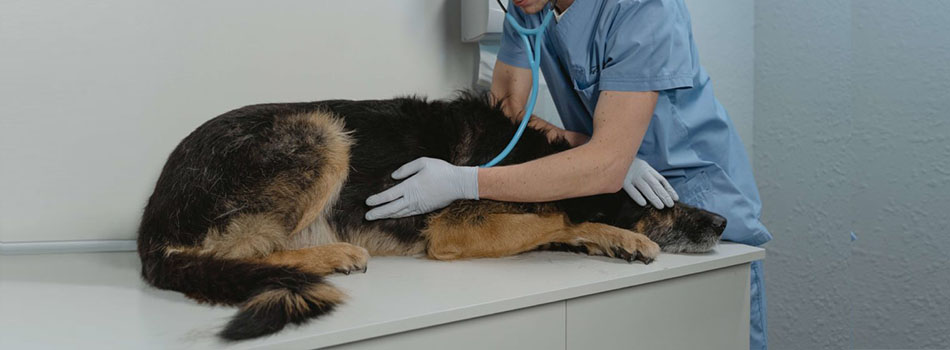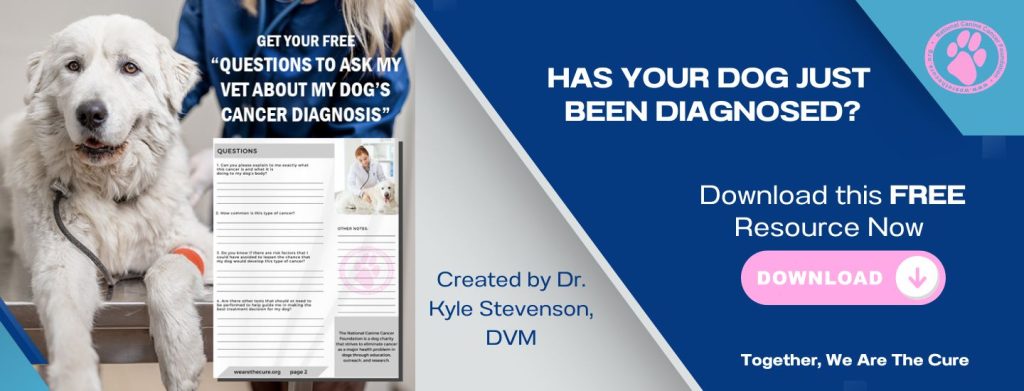Gastric carcinoma (stomach cancer) is a very common cancer in dogs. However, it only accounts for less than 1% of malignant tumors. Left unchecked, cancerous cells in the stomach will interfere with regular gastric function. Usually, a growth will develop on your dog’s tummy or abdomen as a sign of gastric carcinoma. That said, not all lumps point to cancer. Below is some information that can help you make an informed decision if you’ve discovered a lump on your dog’s stomach.
What breeds are most affected by stomach cancer?
Cases of stomach cancer occur in mostly male dogs between the ages of 8 to 10+ years old, though younger dogs may be affected too. German Shepherds are most at risk due to genetic factors. Other breeds at risk include Rough Collies, Standard Poodles, Norwegian Elkhounds, and Staffordshire Bull Terriers.
Types of stomach tumors in dogs
The majority of stomach tumors in dogs are diagnosed as malignant, meaning they are cancerous. If your dog has a cancerous lump, it likely has a kind of gastric adenocarcinoma. This type of cancer occurs in the lining of internal organs and can invade the digestive tract if left unchecked. Though less common, dog owners may also need to watch out for leiomyosarcoma, which occurs in the bone and cartilage, muscle, fat, and blood vessels around the stomach.
Benign stomach tumors are less common in dogs. Although they are non-cancerous, they can still cause harm if they are not treated. One example is the Mast Cell Tumor (MCT). Consisting of blood cells involved with the dog’s response to allergens, MCTs usually occur on the skin but can affect the gastrointestinal tract too. Surgery is usually enough to treat MCTs, but some aggressive types can spread to other parts of the body, leading to health complications such as perforations.
Causes of stomach tumors in dogs
Scientists don’t have a definitive list of causes for stomach tumors in dogs. Malignant tumors seem connected to various factors, including age, sex, breed, and environment. The causes of benign stomach tumors are a little more specific. Hormonal imbalance caused by stress can lead to the development of lumps on a dog’s tummy. Diet, inflammation, and abrasions can also cause non-cancerous stomach tumors to grow in dogs.
Early symptoms of canine stomach cancer
Early detection of stomach cancer in dogs is still a big challenge. However, there are new liquid biopsies that have given hope to dog owners. The most common symptom a dog with stomach cancer will have is vomiting. If your dog is losing weight and throwing up, you may be dealing with stomach cancer.
You may need to visit the vet if your dog is experiencing any of the following:
- Vomiting with blood
- Black stool – an indication of an ulcerated stomach
- Excessive salivation or drooling
- Decreased activity
- Irregular urination and bowel movements
- Lack of appetite
- Weight loss
You know your dog is in pain when it:
- continuously whining (known as vocalization)
- intensely scratches and licks any body part
- Defacates indoors (especially if the dog has been trained to do otherwise)
- Wimpers, yelps, snaps, or runs away when touched
- Has an increased respiratory rate
If your dog has a mass in their abdomen they might experience a swollen stomach.
The symptoms may last anywhere between a couple of weeks to several months, so it’s important to keep an eye on your dog and act quickly.
What to do if your dog has a lump on its stomach?
Stomach lumps can occur for many reasons. If your dog is younger, chances are the growth on its stomach is benign. The story is different for older dogs. If you notice a lump on your dog’s stomach, monitor it closely for any of the above-mentioned symptoms. Should the dog start to present these – or should you feel the stomach lump increasing in size – get your dog examined by the vet.
What is the treatment and cure of dog stomach tumors?
The vet will likely use a combination of treatments to remove the growth on the dog’s stomach. Benign stomach tumors are usually curable with surgery alone. Malignant stomach tumors, on the other hand, may require additional treatments.
 After surgery, the vet will likely keep your dog in for two days to monitor changes. Depending on the situation, your dog may require chemotherapy. The vet oncologist will administer the medication intravenously every two to three weeks. Your dog may need four or five injections. Unlike humans, dogs do not lose their fur during chemotherapy. However, they may experience some vomiting post-treatment, as well as loss of appetite.
After surgery, the vet will likely keep your dog in for two days to monitor changes. Depending on the situation, your dog may require chemotherapy. The vet oncologist will administer the medication intravenously every two to three weeks. Your dog may need four or five injections. Unlike humans, dogs do not lose their fur during chemotherapy. However, they may experience some vomiting post-treatment, as well as loss of appetite.
For cases that can’t be operated on, vets may recommend radiation therapy. This is performed every day for three to four weeks, though the duration depends on the severity of the situation. Radiation therapy is performed under sedation and is painless. That said, your dog may experience side effects like skin conditions, discomfort, and fatigue.
How long will dogs with a tumor on their stomach be able to live?
Malignant stomach tumors are often diagnosed in the advanced stages when cancer has already begun to metastasize. Survival rates are therefore very low, and most dogs don’t make it past 6 months after treatment. There is also a chance of the tumors returning after treatment. Keep monitoring your dog after its treatment, and make sure to regularly check for any recurring lumps on the stomach.
The next time you give your dog a belly rub, check for unusual lumps and bumps. It could be nothing – just a bump – or it could be stomach cancer. As with any cancer, early detection vastly improves chances of survival, so visit the vet if you notice anything odd.
Do you have a story about your dog you’d like to share? We love to hear about the resilience, love, and connection of canine cancer survivors in the comments.
Other Articles of Interest:
Cancer Does Not Necessarily Mean A Death Sentence
Blood Banks For Dogs | Why & How Your Dog Can Donate
Is Fish Oil Good for Dogs? Dosage & Side Effects Every Owner Should Know



Recent Comments